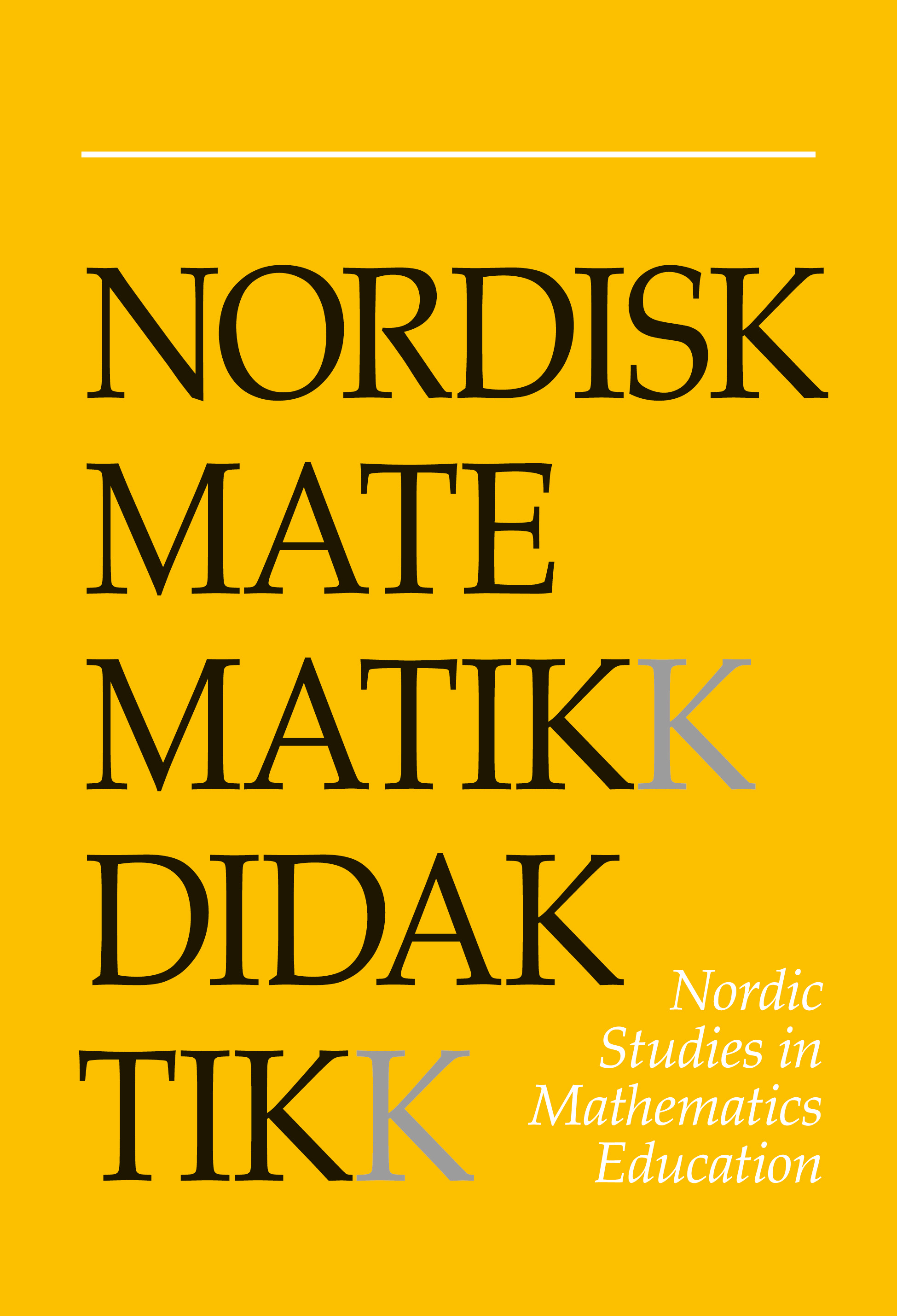On pupils' reactions to the use of open-ended problems in mathematics
DOI:
https://doi.org/10.7146/nomad.v3i4.146189Abstract
This article will focus on the preliminary results of one experimental class from the three-year research project "Open tasks in mathematics", which has been carried out in junior high schools during the years 1989-92 in Helsinki (Finland). The experiment groups used open-ended problems (problem fields) regularly, i.e. once a month, within their normal teaching. The main results from one class (N = 18) were as follows: The pupils liked most of the problem fields used. Their mathematical views did not change statistically significantly, but the non-significant changes in questionnaire ratings, classroom observations and the teacher's evaluations indicate that there was a change, and the change was in most cases positive.
References
Ahtee, M. & Pehkonen, E. (eds.) (1994). Constructivist Viewpointsfor School Learning and Teaching in Mathematics and Science. University of Helsinki. Department of Teacher Education. Research Report 131.
Alseth, B. (1995). Bruk av åpne oppgaver i matematikkundervisningen. Tangenten 1, 18-26.
Anon, G. (1990). Lehrplan Mathematik. Lehrplanrevision Gesamtschule. Sekundarstufe I. Behörde für Schule, Jugend und Berufsbildung, Amt für Schule. Hamburg.
Anon, G. (1991). A Sampler of Mathematics Assessments. Sacramento, Ca: California Dept of Education.
Avital, S. (1992). Exploratory Problems as a Motivational Factor in the Learning of Mathematics. Paper presented in the Working Group 5 of the ICMI-7 conference in Quebec.
Borgensen, H. E. (1994). Open ended problem solving in geometry. Nordic Studies in Mathematics Education 2(2), 6-35.
Clarke, D. J. & Sullivan, P. A. (1992). Responses to open-ended tasks in mathematics: characteristics and implications. In W. Geeslin & K. Graham (eds.), Proceedings of the PME 16 . Volume I, Durham, NH: University of New Hampshire, pp. 137-144.
Cockcroft Report (1982) Mathematics counts. Report of the Committee of Inquiry into the Teaching of Mathematics in Schools. London: H.M.S.O.
Cooney, T., Badger, E. & Wilson, M. (1993). Assessment, Understanding Mathematics, and Distinguishing Visions from Mirages. In N. Webb (ed.), Assessment in the Mathematics Classroom. Yearbook 1993. Reston, Va: NCTM, pp. 239-247.
Davis, R. B., Maher, C. A. & Noddings, N. (eds.) (1990). Constructivist Views on the Teaching and Learning of Mathematics. JRME Monograph Number 4. Reston, Va: NCTM. https://doi.org/10.2307/749908
Mason, J. (1991). Mathematical problem solving: open, closed and exploratory in the UK. International Reviews on Mathematical Education (= ZDM) 23(1), 14-19.
Nohda, N. (1988). Problem solving using "open-ended problems" in mathematics teaching. In H. Burkhardt, S. Groves, A. Schoenfeld & K. Stacey (eds.), Problem Solving - A World View. Nottingham: Shell Centre, pp. 225-234.
Nohda, N. (1991). Paradigm of the "open-approach" method in mathematics teaching: Focus on mathematical problem solving. International Reviews on Mathematical Education (= ZDM) 23(2), 32-37.
Nohda, N. (1995). Teaching and Evaluating Using "Open-Ended Problem" in Classroom. International Reviews on Mathematical Education (= ZDM) 27(2), 57-61.
Pehkonen, E. (1989). Der Umgang mit Problemfeldern im Mathematikunterricht der Sek. I. Beiträge zum Mathematikunterricht 1989, 290-293.
Pehkonen, E. (1992a). Using Problem Fields as a Method of Change. The Mathematics Educator 3(1), 3-6.
Pehkonen, E. (1992b). Problem Fields in Mathematics Teaching. Part 3: The views of Finnish seventh-graders about mathematics teaching. University of Helsinki. Department of Teacher Education. Research Reports 108.
Pehkonen, E. (1993). On Teachers' Criteria to Assess Mathematical Activities. In I. Hirabayashi, N. Nohda, K. Shigematsu & F.-L. Lin (eds.), Proceedings of the seventeenth PME conference. Vol. I. University of Tsukuba, Tsukuba, Japan, pp. 220-227.
Pehkonen, E. (1995). Introduction: Use of Open-Ended Problems. International Reviews on Mathematical Education (= ZDM) 27(2),55-57.
Pehkonen, E. & Zimmermann, B. (1990). Probleemakentät matematiikan opetuksessa. Osa 1: Teoreettinen taustaja tutkimusasetelma. [Problem Fields in Mathematics Teaching. Part 1: Theoretical Background and Research Design.]. University of Helsinki, Department of Teacher Education. Research Report 86.
Shimada, S. (ed.) (1977). Open-end approach in arithmetic and mathematics - A new proposal toward teaching improvement. Tokyo: Mizuumishobo. [in Japanese]*
Silver, E. A. (1993). On mathematical problem posing. In I. Hirabayashi, N. Nohda, K.
Shigematsu & F.-L. Lin (eds.), Proceedings of the seventeenth PME conference. Vol. I. University of Tsukuba, Tsukuba, Japan, pp. 66-85.
Silver, E. A. (1995). The Nature and Use of Open Problems in Mathematics Education: Mathematical and Pedagogical Perspectives. International Reviews on Mathematical Education (= ZDM) 27(2), 67-72.
Silver, E. A. & Mamona, J. (1989). Problem posing by middle school mathematics teachers. In C. A. Maher, G. A. Goldin & R. B. Davis (eds.), Proceedings of PME-NA 11. Volume 1. New Brunswick, NJ: Rutgers University, pp. 263-269.
Solvang, R. (1994). Thoughts about the free phase in connection to the use of generator problem. In R. Solvang (ed.), Selected Topicsfrom Mathematics Education 3. Centre for Teacher Education and In-Service Training, University of Oslo, pp. 56-67.
Stacey, K. (1991). Linking application and acquisition of mathematical ideas through problem solving. International Reviews on Mathematical Education (= ZDM) 23(1), 8-14.
Stacey, K. (1995). The Challenges of Keeping Open Problem-Solving Open in School Mathematics. InternationalReviewsonMathematicalEducation(= ZDM)27(2), 62-67.
Treffers, A. (1991). Realistic mathematics education in The Netherlands 1980-1990. In L. Streefland (ed.), Realistic mathematics education in primary school. Utrecht: Freudenthal Institute, pp. 11-20.
Wiliam, D. (1994). Assessing authentic tasks: alternatives to mark-schemes. NOMAD 2(1), 48-68.
Williams, D. (1989). Assessment of open-ended work in the secondary school. In D. F. Robitaille (ed.), Evaluation and Assessment in Mathematics Education. Science and Technology Education. Document Series 32. Paris: Unesco, pp. 135-140.
Zimmermann, B. (1991). Offene Probleme für den Mathematikunterricht und ein Ausblick auf Forschungsfragen. International Reviews on Mathematical Education (= ZDM) 23(2), 38-46.
Downloads
Published
How to Cite
Issue
Section
License

This work is licensed under a Creative Commons Attribution-NonCommercial-ShareAlike 4.0 International License.



